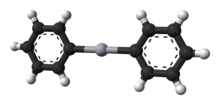Informatics Educational Institutions & Programs
Contents

| |

| |
| Identifiers | |
|---|---|
3D model (JSmol)
|
|
| ChemSpider | |
| ECHA InfoCard | 100.008.734 |
| EC Number |
|
PubChem CID
|
|
| UNII | |
CompTox Dashboard (EPA)
|
|
| |
| |
| Properties | |
| C12H10Hg | |
| Molar mass | 354.80 g mol−1 |
| Appearance | white solid |
| Density | 2.318 g cm−3[1] |
| Melting point | 121 to 123 °C (250 to 253 °F; 394 to 396 K) |
| Boiling point | 204 °C (399 °F; 477 K)[1] |
| slightly soluble in ethanol, diethyl ether; soluble in benzene, chloroform[1] | |
Except where otherwise noted, data are given for materials in their standard state (at 25 °C [77 °F], 100 kPa).
| |
Diphenylmercury is the organomercury compound with the formula Hg(C6H5)2. It is a white solid.[2] The compound is of historic interest as a particularly stable organometallic compound but it finds few uses because of its high toxicity.
Preparation
Commercially available, this compound can be prepared by several routes. It results from treating phenylmercury acetate with sodium stannite,[3] by the reaction of mercuric halides with phenylmagnesium bromide,[4] and the reaction of bromobenzene with sodium amalgam.[5]
Safety
Diphenylmercury is highly toxic.
References
- ^ a b c Lide, D. R. (2008). CRC Handbook of Chemistry and Physics, 89th Edition. CRC Press. pp. 3–518. ISBN 978-0-8493-0488-0.
- ^ Glidewell, C.; Low, J. N.; Wardell, J. L. (2005). "Diphenylmercury, redetermined at 120 K: sheets built from a single C-H···π(arene) hydrogen bond" (PDF). Acta Crystallographica C. 61 (2): m107–m108. doi:10.1107/S0108270104034134. PMID 15695887.
- ^ Maynard, J. L. (1924). "The Direct Mercuration of Benzene and the Preparation of Mercury Diphenyl". Journal of the American Chemical Society. 46 (6): 1510–1512. doi:10.1021/ja01671a024.
- ^ Borgstrom, P.; Dewar, M. M. (1929). "The Preparation of Mercury Diphenyl by Use of the Grignard Reagent". Journal of the American Chemical Society. 51 (11): 3387–3389. doi:10.1021/ja01386a030.
- ^ Calvery, H. O. (1929). "Diphenylmercury". Organic Syntheses. 9: 54; Collected Volumes, vol. 1, p. 228.

















